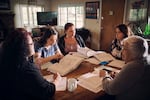
Esther Stutzman and her granddaughter Aiyanna Brown embrace outside of Stutzman's home in Yoncalla, Oregon.
Leah Nash / Underscore News
On a drizzly January morning, Esther Stutzman’s dining room table is covered with sticky notes, worksheets, notepads and several bulky Kalapuya dictionaries. Seated next to Stutzman are her two daughters and granddaughter, all Kalapuyan descendants and enrolled members of the Confederated Tribes of Siletz Indians. Their jovial banter belies the gravity of their mission: to revive the lost language of their ancestors. The scattered documents form a paper trail to their heritage.
“This is probably the biggest group of Kalapuya speakers in the world,” Stutzman said during a semi-regular language study that she launched at her Yoncalla home in western Oregon after the dictionaries were published in December. “And we speak the language at a preschool level.”
The dictionaries are the product of a decade-long passion project by the late Paul Stephen McCartney, Sr., whose fascination with Kalapuya compelled him to devote his post-high school teaching years to compiling and organizing it, and to reach out to the Stutzman family for their assistance. McCartney, who passed away last year at 81, wasn’t a trained linguist but loved language and thought Kalapuya was “beautiful,” according to Aiyanna Brown, Stutzman’s granddaughter. He poured an enormous amount of energy into the dictionary project.
“He wanted to keep the language alive,” Brown said.

From left to right, Melissa Tuttle, Aiyanna Brown, Shannin Stutzman, Heather Moore and Esther Stutzman convene a Kalapuya language study on Jan. 31 in Yoncalla, Oregon.
Leah Nash / Underscore News
McCartney had access to a trove of written materials and a few audio recordings from ethnographic interviews with John Hudson, a Santiam Kalapuyan who died in 1954. Hudson has often been called the last “L1″ Kalapuya speaker, meaning he grew up in a household where the language was spoken first. But linguist Henry Zenk, who holds a Ph.D. in anthropology and is a foremost authority on Oregon Indigenous languages, says at least one other L1 speaker lived longer than Hudson: Stutzman’s great-aunt, Laura Blacketer Albertson, née Fearn. According to Stutzman, Albertson passed away in 1971.
“She was very likely, as far as we know, the last speaker who had grown up with the language from childhood,” Zenk said.
The audio files of Hudson from the 1930s into the 1950s are the lone historical sources of spoken Kalapuya, except for recordings of Kalapuya songs from 1914-1915, according to Zenk and fellow linguist Jedd Schrock, both of whose published works were among the diverse array of essential sources for McCartney’s dictionaries. Additional audio recordings may be housed in the Library of Congress, although researchers haven’t yet located them.
Zenk and Schrock, who have previously collaborated on Kalapuya research, are both linguistic consultants for the Confederated Tribes of Grand Ronde, where many Kalapuyan descendants are enrolled citizens.
The two scholars note that McCartney’s dictionaries aren’t rooted in foundational linguistic practices, which renders them largely unviable as academic resources. But they say the extensive glossary-like wordlists serve as an accessible gateway into the language for non-academics. That assessment is echoed by David Lewis, a professor in Oregon State University’s anthropology and ethnic studies department who advised McCartney early in his efforts.

Kalapuya dictionaries are stacked on a table at Esther Stutzman's home in Yoncalla, Oregon.
Leah Nash / Underscore News
The publications’ usefulness outside of scholarly circles is evident in the informal language sessions at Esther Stutzman’s house. Schrock points out there’s no single way to measure a language or perceive its meaning.
“Different people think about language in different ways,” he said. “To me, language is more behavior than math. We have this enormous mountain of data, but that’s not what language is. It’s not really about all those rules. It’s about what people do together. That’s what makes it a language. The people who can bring back Kalapuya are the Kalapuyan people. So it’s great that Esther and her family are doing this.”
“Language is a thing of heritage,” he added. “If it hasn’t been spoken in a long time, it takes a lot of courage to try to speak it again.”
Schrock is creating a digital archive of Kalapuya language materials for the Confederated Tribes of Grand Ronde’s cultural preservation department. The archive project is a massive undertaking that reflects an unusual characteristic of the language: dead in spoken form but kept alive through a huge compendium of recorded information, stemming from work conducted by anthropologists and linguists in the late 19th and early 20th centuries and further advanced by modern scholars such as Zenk and Schrock.
“North American languages are dying and disappearing tremendously,” Schrock said. “A lot of them are already gone and we don’t have much of a record for them. Kalpauyan is a rare instance where there are no speakers but we have this enormous corpus of existing Kalapuyan records.”
When McCartney dug into that corpus for his project, he approached Stutzman and Lewis, the OSU anthropologist and ethnohistorian, for guidance. While Lewis’ involvement faded, Stutzman remained active throughout the process and enlisted her granddaughter, Brown, who launched a GoFundMe page last year to raise money for printing the dictionaries, just as McCartney’s health was failing.
“When Paul contacted us and asked if we wanted our language back, of course we said yes,” Brown said. “We didn’t even know that was possible.”

Kalapuya language notes are scattered around Esther Stutzman's home, which has served as a meeting spot for language studies and distribution headquarters for the dictionaries.
Leah Nash / Underscore News
On his deathbed and unable to speak, McCartney conveyed a message to Stutzman inquiring about the prospects of publication. Stutzman assured him that the dictionaries would be printed. McCartney died two days later.
Thanks to $10,000 raised through GoFundMe, the first run of 100 dictionaries was printed in December. Each four-volume set contains more than 3,000 pages and weighs 20 pounds, with two books of English-Kalapuya translations and two of Kalapuya-English. Stutzman’s house has served as distribution headquarters for the 400 heavy tomes.
As of late February, all of the dictionaries had either been delivered or committed to individuals and institutions, including K-12 schools and universities, at no cost but with the suggestion of a $150 donation to the Stutzman family’s nonprofit called the Komemma Cultural Protection Association. Among the recipients are the University of Oregon, Oregon State University and Portland State University.
The family ordered a second run of 50 sets, funded by an additional $3,000 raised through GoFundMe, the suggested donations and contributions from organizations such as Zelle, which also partnered with BuzzFeed on a video about the Stutzmans’ efforts. As long as there is demand and funding, Brown says the printings will continue.
The Stutzmans emphasize that oral storytelling is integral to Kalapuyan culture. Esther, 79, is a respected storyteller and hopes to acquire enough language skills to convey those tales, or at least portions, in Kalapuya. Brown, 22, is proud to help facilitate a deeper cultural understanding among her generation and for future generations, including her own kids someday. She called her role in the project “empowering.”
“Our main hope for the dictionaries is to share our language,” Brown said. “As long as we’re getting our language and culture out there and getting more people to see it and understand it, it has less of a chance to die off.”
“Language connects people back to their heritage,” she continued, “and this is another way for us to connect back to our homelands and to our ancestors. I know it sounds hoity toity, but I really do feel this is a way to connect and communicate with our ancestors and keep those traditions that are so rich alive.”

Photos adorn a wall inside Esther Stutzman's home, including a late 1800s photograph of Chief Halo, leader of the Yoncalla Kalapuya tribe and a direct ancestor of the Stutzman family.
Leah Nash / Underscore News
According to Lewis, who has a Ph.D. in anthropology, the Kalapuya people have lived in western Oregon for close to 15,000 years, once occupying more than a million acres in the Willamette and Umpqua valleys. Zenk said Kalapuyans were mentioned in Lewis and Clark’s journals, although the Corps of Discovery never crossed paths with them. The first documented Euro-American contact came by way of fur traders in 1811, according to Zenk.
Lewis, who is the great-great grandson of John Hudson, says about 20,000 Kalapuyans historically lived in as many as 19 tribes and bands divided linguistically by regions of the Willamette Valley: northern, central and southern. By 1850, that number had dwindled to about 1,000, a catastrophic decline fueled by white settlers introducing new diseases. Kalapuyans were among several western Oregon tribes to sign treaties with the U.S. government between 1848-1855.
Zenk and Lewis both contribute essays to oregonencyclopedia.org that serve as authoritative and accessible resources about the histories and cultures of Indigenous peoples in Oregon, including Kalapuya. Lewis also writes essays on his own website.
Over the years, Lewis said people have occasionally expressed surprise that Kalapuyans are still around and that modern Native Americans exist at all.
“I say, ‘Well, I’m here,’” Lewis said. “I feel like for the longest time Kalapuyans were ignored. We were written out of history books. It’s almost as if history began with settlers, white people in the area. But we’re starting to see more interest. The dictionary is a stepping stone to help bring more interest and attention to the language itself and the culture.”

Esther Stutzman and her granddaughter Aiyanna Brown, who are Kalapuyan descendants, have spearheaded the effort to print and distribute the Kalapuya-English dictionaries published last winter.
Leah Nash / Underscore News
The best-preserved Kalapuya dialects, according to Zenk and Schrock, are northern Tualatin and the central dialects of Mary’s River and Santiam, which John Hudson spoke. The Stutzmans’ linguistic lineage is traced back to Yoncalla, the southernmost tribe for which only spotty wordlists and sentence documentations exist, largely derived from the field notes of anthropologist Melville Jacobs’ interviews with Albertson, Esther’s great-aunt, in the late 1920s. McCartney’s dictionaries distinguish between the various dialects, which are distinct but similar.
In 2017, Zenk and Schrock published a book about Louis Kenoyer, the last known speaker of Tualatin Kalapuya. Kenoyer had dictated his life story to researchers in 1928 and 1937, but he passed away before the narrative was fully translated. Zenk and Schrock translated the rest, a feat of yeoman’s work that resulted in “My Life, by Louis Kenoyer: Reminiscences of a Grand Ronde Reservation Childhood.”
The scholars drew from the narrative’s previously translated portions, as well as linguistic, ethnographic and historical documentation. But they were never able to track down the 1928 audio recordings of Kenoyer that they believe exist.
“They are likely sitting somewhere on magnetic wire in the bowels of the Library of Congress,” Schrock said.

Three generations: From left to right, Esther Stutzman, her daughter Shannin Stutzman and Shannin's daughter Aiyanna Brown stand outside Esther's home in Yoncalla in western Oregon.
Leah Nash / Underscore News
Brown acknowledges that the dictionaries are a “starting point,” not an all-in-one resource for fluency. But their role in catalyzing linguistic enthusiasm was on display in January as Brown, her mother, grandmother, aunt and a family friend worked their way through a series of Kalapuya language lessons, each person at the table thumbing through a dictionary. There was particular appreciation for a worksheet entitled “vulgarisms.”
Playfulness is a key component of the language sessions, and Brown said participants have fun creating “adaptive words.” An example is “lakayuhodna,” roughly translated as “faraway seeing tool,” a vernacular amalgamation they crafted to describe a TV, which hadn’t yet been invented when the language was widely used.
Stutzman, who is also descended from western’s Oregon’s Coos people, hopes more participants will join the language studies, either through Zoom or in person if COVID allows. More broadly, she would like to see the efforts seep into everyday life, especially among kids. It could be as simple as using a few words to describe common objects, with more terms added incrementally over time. Even if no verbs or grammar are involved, tiptoeing into immersion establishes pathways to cultural connection.
“We’re really wanting to get this thing rolling and get a lot more people involved,” Stutzman said.
Zenk says it would be an “uphill struggle to bring Kalapuya back as a living language,” but it has been done before, notably with Hebrew. Schrock is more optimistic about the chances of revival, or at least a version of restoration that tips the scale a bit further toward living than dead.
“You lose a language, you lose a culture,” Schrock said. “A culture and a language are really the same thing. Language represents how a group of people at a given time conceptualize the world. We’re all sort of stuck in our concepts of the world because we speak English. A language comes about because of a group of people’s experience. When you lose a language, you lose all of that human experience. That way of seeing the world goes away and we’re stuck with only the Eurocentric way of thinking about the world.”
Underscore is a nonprofit collaborative reporting team in Portland focused on investigative reporting and Indian Country coverage. We are supported by foundations, corporate sponsors and donor contributions. Follow Underscore on Facebook and Twitter.